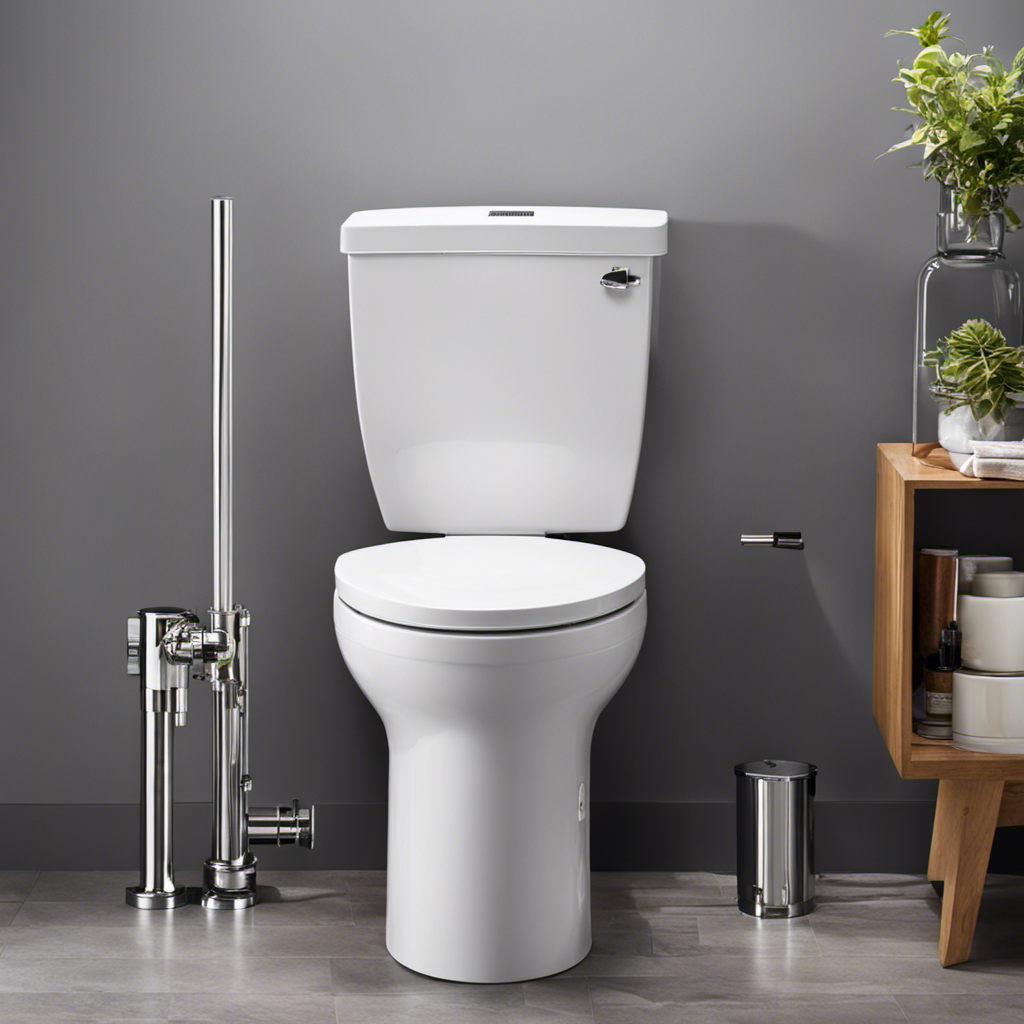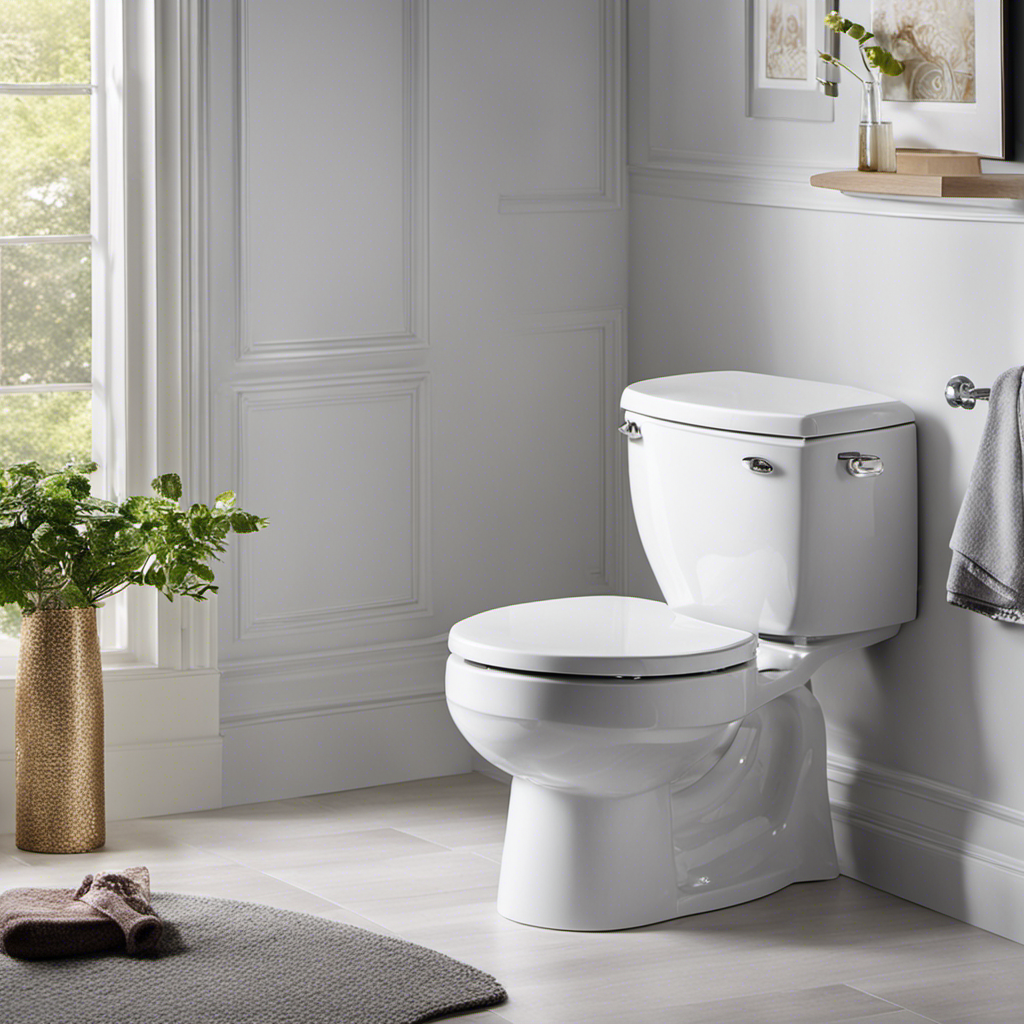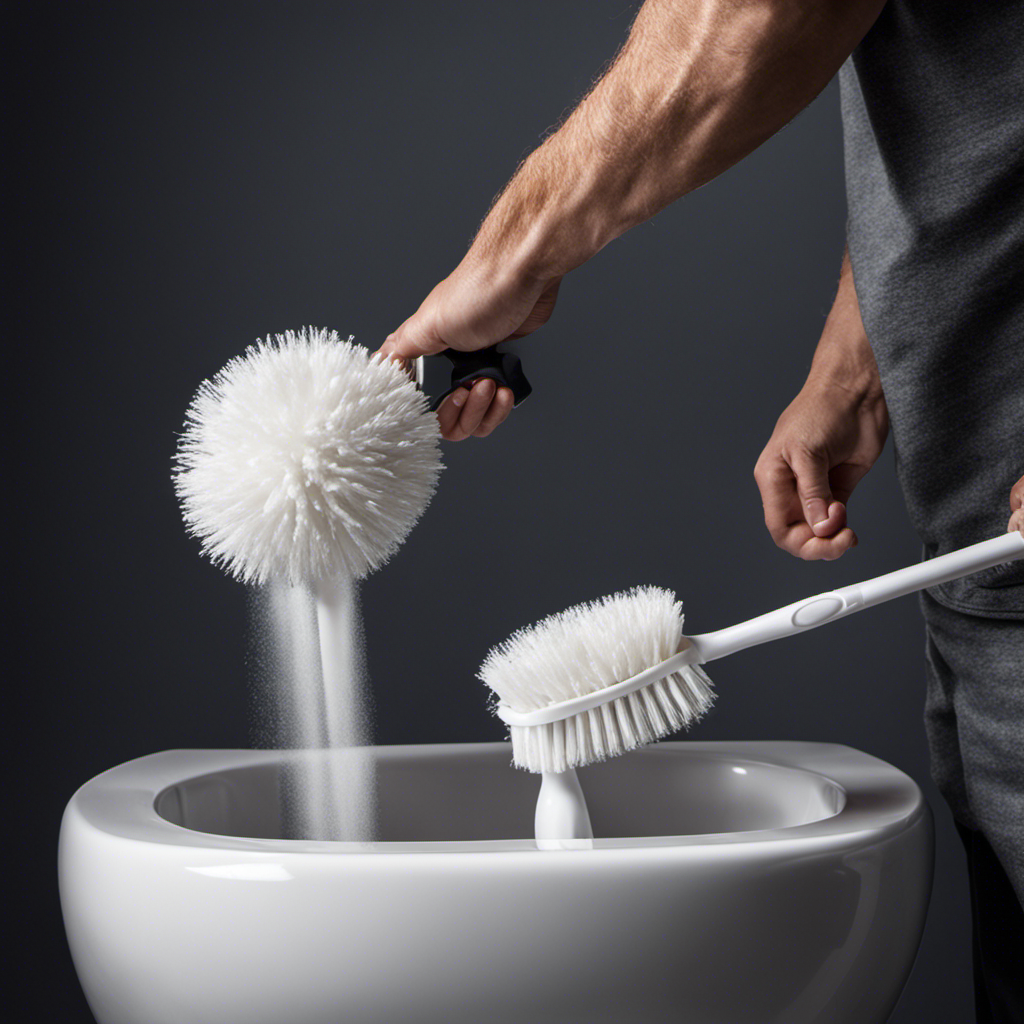So, you’re curious about how a macerating toilet works? Well, let me break it down for you.
This ingenious bathroom fixture may seem like something out of a sci-fi movie, but it’s actually a marvel of engineering. With its powerful maceration process and cleverly designed components, a macerating toilet can efficiently handle waste like a champ.
In this article, I’ll walk you through the inner workings of a macerating toilet, from its function to its advantages and even troubleshooting tips.
Get ready to be amazed!
Key Takeaways
- Macerating toilets break down waste and toilet paper into a slurry before pumping it away.
- They use a powerful macerator pump with rotating blades for efficient maceration.
- Macerating toilets can be installed in areas where traditional gravity-based toilets are not possible.
- Macerating toilets offer benefits such as efficient waste disposal, reduced water consumption, and easy installation.
The Function of Macerating Toilets
Macerating toilets work by breaking down waste and toilet paper into a slurry before pumping it away. Understanding macerating technology is crucial when comparing different macerating toilets.
These toilets utilize a powerful macerator pump that grinds up solid waste and toilet paper into small particles. The macerator pump is equipped with sharp blades that rotate at high speeds, ensuring efficient maceration.
This finely ground slurry is then transported through small diameter pipes to a remote location, such as a septic tank or sewage system. The advantage of macerating toilets is that they can be installed in areas where traditional gravity-based toilets are not possible.
With this understanding of the maceration process, let’s delve deeper into the inner workings of these innovative toilets.
Understanding the Maceration Process
The maceration process involves breaking down waste into smaller particles for easier disposal. Unlike traditional toilet systems, macerating toilets use a powerful motor to shred waste and toilet paper into fine pieces. This macerated waste is then mixed with water and pumped into the drainage system.
The maceration process not only eliminates the need for a large water tank, but also allows for flexible installation options, as the waste can be pumped vertically or horizontally to reach the main sewer line.
In terms of environmental impact, macerating toilets offer several advantages. Firstly, they use significantly less water compared to traditional toilets, reducing water consumption and conserving this precious resource. Secondly, the maceration process reduces the amount of waste that enters the sewage system, minimizing the risk of blockages and overflows. Lastly, the smaller waste particles produced by macerating toilets can be more easily treated and processed in wastewater treatment plants, leading to a more efficient and environmentally friendly disposal process.
Key Components of a Macerating Toilet
When it comes to macerating toilets, understanding the pumping mechanism is crucial.
The pumping mechanism in a macerating toilet involves a motor-driven macerator that breaks down waste into a fine slurry before pumping it through small-diameter pipes.
This efficient and compact system allows for flexible installation options and eliminates the need for costly and disruptive plumbing modifications.
Plus, with the maceration process, macerating toilets offer numerous benefits, including efficient waste disposal, reduced water consumption, and the ability to install a toilet in unconventional spaces.
Pumping Mechanism Explanation
With a macerating toilet, the waste is broken down and pumped through small pipes using a motorized blade. The pumping mechanism of a macerating toilet is designed to efficiently macerate and pump waste, ensuring smooth flow through the plumbing system.
The motorized blade, also known as the macerator, is located inside the macerating unit. When the toilet is flushed, the waste and water enter the macerating unit. The motorized blade then rotates at high speed, cutting and macerating the waste into smaller particles. These particles are then mixed with water to create a slurry, which is pumped through the small pipes.
The macerating unit is equipped with a powerful pump that propels the slurry to the main sewer line or septic tank. It is important to note that regular maintenance is required to keep the macerating toilet functioning properly. This includes periodic inspections, cleaning of the macerating unit, and proper disposal of non-flushable items to prevent clogging and damage to the system.
Benefits of Macerating Toilets
One of the benefits of macerating toilets is that they can be installed in locations where traditional plumbing is not feasible. This makes them a versatile option for various settings, such as basements, garages, or even boats. Macerating toilets are designed with a built-in macerator, which breaks down waste into smaller particles before pumping it through small diameter pipes. This system allows for easy installation and eliminates the need for large-scale plumbing infrastructure. Additionally, macerating toilets require minimal maintenance compared to traditional toilets. Regular cleaning and inspection of the macerator and pump are necessary to ensure proper functioning. In terms of environmental impact, macerating toilets use less water per flush, contributing to water conservation efforts. Overall, their flexibility, low maintenance requirements, and reduced water usage make macerating toilets an advantageous choice.
| Benefits of Macerating Toilets | ||
|---|---|---|
| Versatile installation | Low maintenance | Water conservation |
| Suitable for various locations | Regular cleaning and inspection required | Reduced water usage |
| Easy installation | ||
| Elimination of large-scale plumbing infrastructure |
How Macerating Toilets Handle Waste
Macerating toilets use a powerful blade to break down waste into smaller pieces. This blade, located inside the macerating unit, spins at high speeds, effectively shredding and grinding solid waste. Here’s how macerating toilets handle waste:
- Waste enters the toilet bowl and is flushed down into the macerating unit.
- The blade inside the unit starts spinning, cutting waste into smaller particles.
- Water is then added to create a slurry-like mixture.
- The slurry is pumped out of the macerating unit using a motorized pump.
- The waste is then transported through a small-diameter discharge pipe to the main sewage line or a designated drain.
Understanding how macerating toilets handle waste is crucial when considering toilet installation options. Some popular macerating toilet brands include Saniflo, Liberty Pumps, and SFA Group.
Now that we’ve covered the process, let’s explore the advantages of using a macerating toilet.
Advantages of Using a Macerating Toilet
Using a macerating toilet offers several advantages. One of these is easy installation, allowing the toilet to be placed in unconventional locations. Another advantage is the cost effectiveness of a macerating toilet. Unlike traditional toilets that require extensive plumbing work, a macerating toilet can be installed with minimal disruption and at a lower cost.
The installation process involves connecting the toilet to a macerator pump. This pump breaks down waste into a fine slurry that can be easily transported through small pipes. This allows for flexibility in positioning the toilet, as it can be placed farther away from existing plumbing lines.
Additionally, the macerating toilet’s compact design makes it suitable for installation in basements, attics, or any other space with limited plumbing access.
Transitioning to the next section, let’s now discuss troubleshooting common macerating toilet issues.
Troubleshooting Common Macerating Toilet Issues
When it comes to troubleshooting common issues with macerating toilets, there are a few key points to keep in mind.
First, clogged pipes and drains can be a major issue, causing backups and slow drainage.
Second, strange noises and vibrations can indicate a problem with the macerator or pump, requiring further investigation.
Lastly, inconsistent flushing performance can be a sign of a malfunctioning macerating system, which may need to be repaired or replaced.
It is important to address these issues promptly to ensure the proper functioning of the macerating toilet system.
Clogged Pipes and Drains
If your pipes and drains are clogged, you might want to consider a macerating toilet as a solution. This innovative plumbing fixture can help alleviate clogged drain issues and prevent pipe blockages.
Here are some key benefits of using a macerating toilet:
-
Efficient waste disposal: The macerating toilet uses a powerful motor to grind waste into a fine slurry, making it easier to flush through small pipes.
-
Versatile installation: Macerating toilets can be installed in areas where traditional plumbing is not feasible, such as basements or attics.
-
Space-saving design: These toilets have a compact footprint, making them ideal for small bathrooms or locations with limited space.
-
Minimal maintenance: Macerating toilets have self-cleaning mechanisms that help prevent buildup and clogs.
-
Environmentally friendly: By grinding waste into smaller particles, macerating toilets reduce the amount of water needed for flushing.
By incorporating a macerating toilet into your plumbing system, you can effectively tackle clogged drain issues and enjoy a hassle-free experience.
Now, let’s move on to discussing strange noises and vibrations that may arise with macerating toilets.
Strange Noises and Vibrations
After discussing the issue of clogged pipes and drains, let’s now move on to the topic of strange noises and vibrations in a macerating toilet.
One of the common problems that can occur with these toilets is noisy operation. If you notice any unusual sounds coming from your macerating toilet, it’s important to address them promptly. The noise could be a result of a worn-out motor or damaged components within the macerator unit. To resolve this issue, repair options include replacing the faulty parts or, if necessary, the entire macerator unit. It’s always recommended to consult a professional if you’re not familiar with the repair process.
Now, let’s delve into the next subtopic, which is inconsistent flushing performance.
Inconsistent Flushing Performance
The inconsistent flushing performance of a macerating toilet can be caused by a variety of issues. It is important to consider proper toilet installation and water pressure adjustments to ensure optimal performance. Here are five possible reasons for the inconsistent flushing:
-
Incorrect installation: If the macerating toilet is not installed properly, it can lead to poor flushing performance. It is crucial to follow the manufacturer’s instructions and ensure all connections are secure.
-
Clogged macerator: A clog in the macerator can impede the flushing process. Regular maintenance and cleaning of the macerator can help prevent clogs and ensure smooth operation.
-
Low water pressure: Insufficient water pressure can result in weak flushing. Adjusting the water pressure to the recommended level can help improve the flushing performance.
-
Faulty components: Damaged or worn-out components such as the macerator blade or impeller can affect the flushing performance. Regular inspection and replacement of faulty components are essential.
-
Blockage in the drainage system: A blockage in the drainage system can restrict the flow of waste, leading to inconsistent flushing. Clearing the blockage or seeking professional assistance may be necessary to resolve this issue.
Maintenance Tips for Macerating Toilets
One important tip for maintaining macerating toilets is to regularly clean the tank and pump. Proper maintenance is crucial to ensure the efficient functioning of macerating toilets.
To start, turn off the water supply and disconnect the power source. Remove the access panel and locate the tank and pump. Carefully remove any debris or buildup from the tank using a brush or sponge. Inspect the pump for any clogs or obstructions and remove them if necessary.
It is also recommended to clean the macerating unit using a specialized cleaner to prevent odors and maintain optimal performance.
When choosing a macerating toilet, consider reputable brands such as Saniflo, Liberty Pumps, or SFA. These brands are known for their reliability, durability, and ease of installation.
Frequently Asked Questions
How Much Water Does a Macerating Toilet Use Compared to a Traditional Toilet?
A macerating toilet is more water-efficient compared to a traditional toilet. It uses less water per flush, reducing environmental impact. This is achieved through its macerating system, which breaks down waste into smaller particles before flushing.
Can a Macerating Toilet Be Installed in Any Location in a House?
Installing a macerating toilet brings many benefits, but there are installation restrictions. These toilets can be placed in any location in a house as long as there is access to water and a drain line.
Is It Possible to Connect Multiple Fixtures to a Single Macerating Toilet System?
Yes, it is possible to connect multiple fixtures to a single macerating toilet system. However, it is crucial to ensure plumbing compatibility and follow manufacturer guidelines to avoid any potential issues with the system.
Are Macerating Toilets Noisy When in Operation?
No, macerating toilets are not noisy when in operation. The design of the macerator pump minimizes noise by using quiet motors and soundproofing materials. This ensures a peaceful bathroom experience without disturbing anyone nearby.
How Often Do Macerating Toilets Require Maintenance or Servicing?
Macerating toilet maintenance frequency varies depending on usage and proper care. Regular servicing is recommended every 1-2 years, including checking the blades, seals, and pump. Troubleshooting tips can help address common issues.
Conclusion
In conclusion, the macerating toilet is a revolutionary plumbing solution that efficiently handles waste in a compact and convenient manner. By using a powerful maceration process, this toilet breaks down waste into a fine slurry, allowing it to be easily transported through small pipes.
The key components of the macerating toilet, including the macerator pump and the cutting blades, work seamlessly together to ensure smooth operation. With its numerous advantages, such as flexibility in installation and reduced plumbing costs, the macerating toilet is a smart choice for any modern bathroom.
Remember to follow proper maintenance tips and troubleshoot common issues to keep your macerating toilet functioning optimally.










